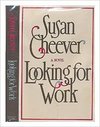

Carregue numa fotografia para ir para os Livros Google.
|
A carregar... Werk zoeken (edição 1987)por Susan Cheever, Nan Lenders
Informação Sobre a ObraLooking for Work por Susan Cheever
 Nenhum(a) Ainda não há conversas na Discussão sobre este livro.   ) )sem críticas | adicionar uma crítica
Pertence à Série da EditoraGrote ABC (569)
Não foram encontradas descrições de bibliotecas. |
Current DiscussionsNenhum(a)
 Google Books — A carregar... Google Books — A carregar...GénerosSistema Decimal de Melvil (DDC)813.5Literature English (North America) American fiction 20th CenturyClassificação da Biblioteca do Congresso dos EUA (LCC)AvaliaçãoMédia: (3.06) (3.06)
É você?Torne-se num Autor LibraryThing. |
|||||||||||||||||||||||||||||||||||||||||||||||||||||||||||||||||||||||||||||||||||||||||||||||||||||||||||||||||||||||